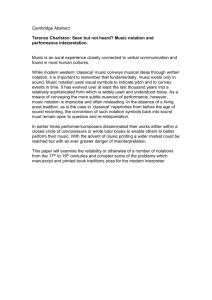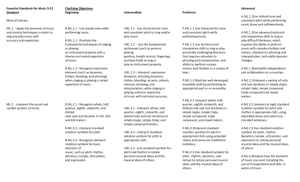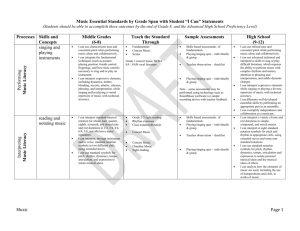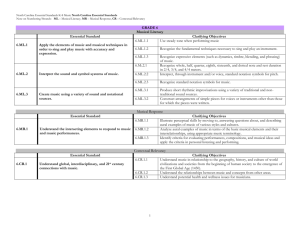Music Standards for All Grades
advertisement
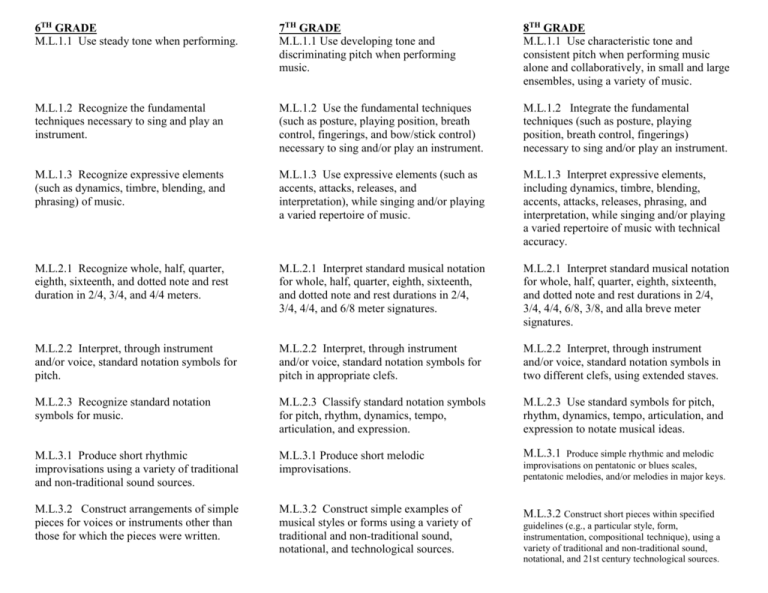
6TH GRADE M.L.1.1 Use steady tone when performing. 7TH GRADE M.L.1.1 Use developing tone and discriminating pitch when performing music. 8TH GRADE M.L.1.1 Use characteristic tone and consistent pitch when performing music alone and collaboratively, in small and large ensembles, using a variety of music. M.L.1.2 Recognize the fundamental techniques necessary to sing and play an instrument. M.L.1.2 Use the fundamental techniques (such as posture, playing position, breath control, fingerings, and bow/stick control) necessary to sing and/or play an instrument. M.L.1.2 Integrate the fundamental techniques (such as posture, playing position, breath control, fingerings) necessary to sing and/or play an instrument. M.L.1.3 Recognize expressive elements (such as dynamics, timbre, blending, and phrasing) of music. M.L.1.3 Use expressive elements (such as accents, attacks, releases, and interpretation), while singing and/or playing a varied repertoire of music. M.L.1.3 Interpret expressive elements, including dynamics, timbre, blending, accents, attacks, releases, phrasing, and interpretation, while singing and/or playing a varied repertoire of music with technical accuracy. M.L.2.1 Recognize whole, half, quarter, eighth, sixteenth, and dotted note and rest duration in 2/4, 3/4, and 4/4 meters. M.L.2.1 Interpret standard musical notation for whole, half, quarter, eighth, sixteenth, and dotted note and rest durations in 2/4, 3/4, 4/4, and 6/8 meter signatures. M.L.2.1 Interpret standard musical notation for whole, half, quarter, eighth, sixteenth, and dotted note and rest durations in 2/4, 3/4, 4/4, 6/8, 3/8, and alla breve meter signatures. M.L.2.2 Interpret, through instrument and/or voice, standard notation symbols for pitch. M.L.2.2 Interpret, through instrument and/or voice, standard notation symbols for pitch in appropriate clefs. M.L.2.2 Interpret, through instrument and/or voice, standard notation symbols in two different clefs, using extended staves. M.L.2.3 Recognize standard notation symbols for music. M.L.2.3 Classify standard notation symbols for pitch, rhythm, dynamics, tempo, articulation, and expression. M.L.2.3 Use standard symbols for pitch, rhythm, dynamics, tempo, articulation, and expression to notate musical ideas. M.L.3.1 Produce short rhythmic improvisations using a variety of traditional and non-traditional sound sources. M.L.3.1 Produce short melodic improvisations. M.L.3.1 Produce simple rhythmic and melodic M.L.3.2 Construct arrangements of simple pieces for voices or instruments other than those for which the pieces were written. M.L.3.2 Construct simple examples of musical styles or forms using a variety of traditional and non-traditional sound, notational, and technological sources. M.L.3.2 Construct short pieces within specified improvisations on pentatonic or blues scales, pentatonic melodies, and/or melodies in major keys. guidelines (e.g., a particular style, form, instrumentation, compositional technique), using a variety of traditional and non-traditional sound, notational, and 21st century technological sources. 6TH GRADE M.R.1.1 Illustrate perceptual skills by moving to, answering questions about, and describing aural examples of music of various styles and cultures. 7TH GRADE M.R.1.1 Execute specific gestures of a conductor in response to the various elements of music (such as meter, dynamics, phrasing, etc.). 8TH GRADE M.R.1.1 Interpret the gestures of a conductor when singing or playing an instrument M.R.1.2 Analyze aural examples of music in terms of the basic musical elements and their interrelationships, using appropriate music terminology. M.R.1.2 Analyze aural musical examples representing diverse genres, styles, and cultures, using appropriate music terminology. M.R.1.2 Identify principles of meter, rhythm, tonality, intervals, chords, and harmonic progressions using appropriate music terminology in analyses of music. M.R.1.3 Identify criteria for evaluating performances, compositions, and musical ideas and apply the criteria in personal listening and performing. M.R.1.3 Evaluate the quality and effectiveness of performances, compositions, arrangements, and improvisations by applying specific criteria appropriate for the style of the music. M.R.1.3 Evaluate performances, compositions, and musical ideas using a specified set of criteria (such as tone quality, intonation, blend/ balance, technique, musical effect, interpretation, and diction). C.R.1.1 Understand music in relationship to the geography, history, and culture of world civilizations and societies from the beginning of human society to the emergence of the First Global Age (1450). C.R.1.1 Understand music in relationship to the geography, history, and culture of modern societies from the emergence of the First Global Age (1450) to the present. C.R.1.1 Understand the role of music in North Carolina and the United States in relation to history and geography. C.R.1.2 Understand the relationships between music and concepts from other areas. C.R.1.2 Understand the relationships between music and concepts from other areas. C.R.1.2 Understand the relationships between music and concepts from other areas C.R.1.3 Understand potential health and wellness issues for musicians. C.R.1.3 Understand the functions music serves, roles of musicians, and conditions under which music is typically performed. C.R.1.3 Understand laws regarding the proper access, use, and protection of music.
